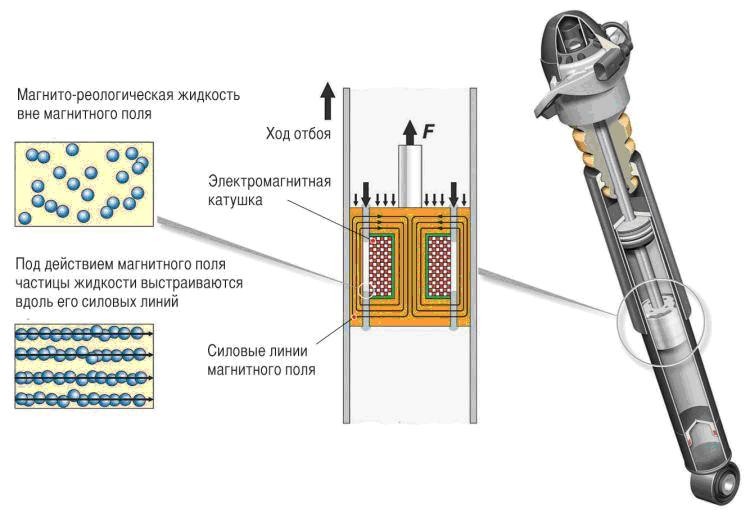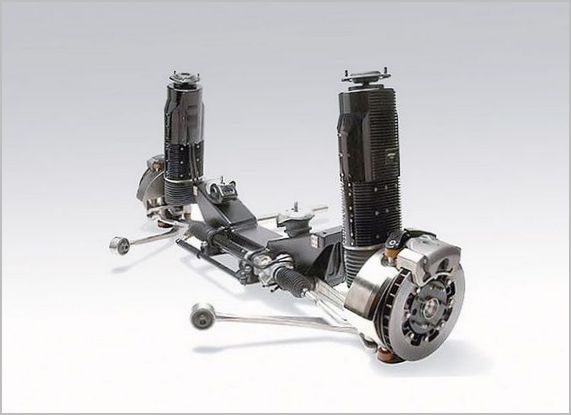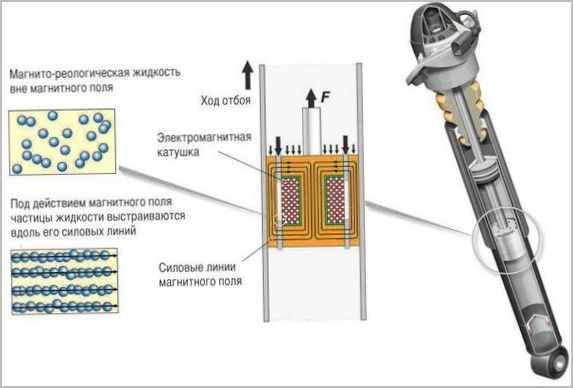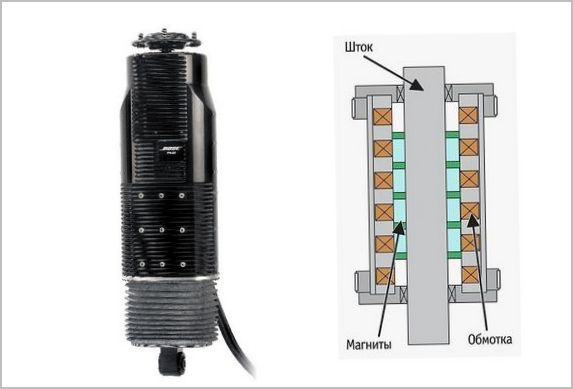
Features and device of electromagnetic suspension
Content
Electromagnetic, sometimes simply called magnetic, suspensions occupy their own, completely separate place in a number of various technical solutions for automobile chassis elements. This is possible due to the use of the fastest way to control the force characteristics of the suspension - directly using a magnetic field. This is not hydraulics, where the fluid pressure still needs to be increased by a pump and inert valves, or pneumatics, where everything is determined by the movement of air masses. This is an instant reaction at the speed of light, where everything is determined solely by the pace of the control computer and its sensors. And the elastic and damping elements will react instantly. This principle gives the pendants fundamentally new qualities.

What is magnetic suspension
These are not exactly floating in space, unrelated objects, but something similar is happening here. The active assembly, working on the interaction of magnets, resembles a conventional strut with a spring and a shock absorber, but fundamentally differs from it in everything. The repulsion of the electromagnet poles of the same name works as an elastic element, and quick control by changing the electric current flowing through the windings allows you to quickly change the strength of this repulsion.
Pendants designed by different companies are built in different ways. Some of them are full-fledged, but working on other principles, combinations of an elastic element and a damper, others are able to change only the characteristics of the shock absorber, which in most cases is enough. It's all about speed.
Versions
There are three well-known and well-developed real systems based on the interaction of electromagnets in suspension struts. They are offered by Delphi, SKF and Bose.
Delphi systems
The simplest implementation, here the rack contains a conventional coil spring and an electrically controlled shock absorber. The company quite rightly singled it out as the most important part of the controlled suspension. Static stiffness is not so important, it is much more useful to control properties in dynamics.

To do this, a classical type shock absorber is filled with a special ferromagnetic fluid that can be polarized in a magnetic field. Thus, it became possible to change the viscosity characteristic of shock absorber oil at high speed. When passing through calibrated jets and valves, it will provide different resistance to the piston and shock absorber rod.
The suspension computer collects signals from numerous vehicle sensors and regulates the current in the electromagnet winding. The shock absorber responds to any change in operating mode, for example, it can quickly and smoothly work out bumps, keep the car from rolling in a turn, or prevent dive when braking. The stiffness of the suspension can be chosen at your own discretion from the available fixed settings for varying degrees of sportiness or comfort.
Magnetic spring element SKF
Here the approach is completely different, the control is based on the principle of changing elasticity. The main classical spring is missing; instead, the SKF capsule contains two electromagnets that repel each other depending on the strength of the current applied to their windings. Since the process is very fast, such a system can work as an elastic element or as a shock absorber, applying the necessary force in the right direction to dampen vibrations.

There is an additional spring in the rack, but it is used only as insurance in case of electronics failures. The disadvantage is the very high power consumed by the electromagnets, which is necessary to create a force of the order that is usually manifested in automobile suspensions. But they coped with this, and the increase in the load on the on-board electrical network has long become a general trend in the automotive industry.
Magnetic suspension from Bose
Professor Bose has been working on loudspeakers all his life, so he used the same principle in the active suspension element as there - the movement of a current-carrying conductor in a magnetic field. Such a device, where a multi-pole magnet of the rack rod moves inside a set of ring electromagnets, is usually called a linear electric motor, since it is approximately the same, only the rotor and stator system is deployed in a line.

The multi-pole motor is more efficient than the SKF XNUMX-pole system, so the power consumption is noticeably lower. Many other benefits as well. The speed is such that the system can remove the signal from the sensor, reverse its phase, amplify and thus fully compensate for road irregularities with the suspension. Something similar happens in active noise-cancellation systems using car audio setups.
The system works so efficiently that its first tests showed a qualitative superiority even over standard premium car suspensions. At the same time, the length of the linear electromagnets provided a significant suspension travel and good energy consumption. And an additional bonus turned out to be the ability not to dissipate the energy absorbed during the damping process, but to convert it using the reverse of electromagnets and send it to a storage device for later use.
Suspension management and realization of the benefits provided
The possibilities of magnetic mechanisms in the suspension are fully revealed with the organization of a sensor system, a high-speed computer and well-developed software principles. The results are simply amazing:
- smooth running above all expectations;
- complex suspension reactions in corners, highlighting loaded and starting to rise wheels;
- parrying pecks and pickups of the body;
- complete damping of rolls;
- emancipation of pendants on difficult terrain;
- solving the problem of unsprung masses;
- collaboration with cameras and radars scanning the road in front of the car for pre-emptive actions;
- the possibility of working out navigation charts, where the surface relief is pre-recorded.
Nothing better than magnetic pendants has yet been invented. The processes of further development and the creation of algorithms continue, development is going on even on cars of the highest classes, where the price of such devices is justified. It has not yet reached the point of being used on mass-produced chassis, but it is already quite clear that the future belongs to such systems.